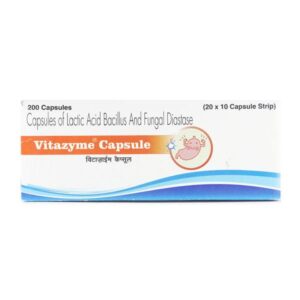FUNGAL DIASTASE + LACTIC ACID BACILLUS
Fungal Diastase: Fungal Diastase is an enzyme that is used as a digestive aid. It is primarily used to treat digestive disorders where there is a deficiency in the production of digestive enzymes, such as in malabsorption syndrome or digestive enzyme deficiencies.
The mechanism of action of Fungal Diastase involves the breakdown of carbohydrates into simpler sugars. It works by catalyzing the hydrolysis of starch, converting it into dextrin and maltose. This enzymatic activity helps in the digestion of carbohydrates and promotes their absorption in the small intestine.
Fungal Diastase is typically available in tablet or liquid form. The usual recommended dose for adults is 1-2 tablets or 5-10 ml of liquid, taken orally, before or with meals. The dose for children may vary depending on their age and weight, so it is important to consult a healthcare professional for proper dosing instructions.
Most people tolerate Fungal Diastase well, but like any medication, it may have side effects. Common side effects include nausea, diarrhea, bloating, and stomach discomfort. These are usually mild and transient. If any side effects persist or worsen, it is advisable to seek medical attention.
It is important to note that Fungal Diastase is not intended for self-diagnosis or self-medication. It should be used only under the guidance and supervision of a healthcare professional. They can determine the appropriate dose and duration of treatment based on the individual’s specific condition and needs.
Lactic Acid Bacillus: Lactic Acid Bacillus is a probiotic drug commonly used to restore and maintain the natural balance of bacteria in the gastrointestinal tract. It contains live bacteria called Lactobacillus, particularly Lactobacillus acidophilus, which is a beneficial bacterium naturally found in the human gut.
The main use of Lactic Acid Bacillus is to treat and prevent various digestive disorders such as diarrhea, irritable bowel syndrome, and other conditions associated with an imbalance of gut bacteria. When taken orally, it helps replenish and enhance the presence of beneficial bacteria in the intestines, which improves digestion and supports a healthy immune system.
The mechanism of action of Lactic Acid Bacillus involves the release of antimicrobial substances that inhibit the growth of harmful bacteria in the gut. It also produces lactic acid, which creates an acidic environment that inhibits the growth of pathogens. Additionally, Lactobacillus acidophilus helps promote the breakdown and absorption of nutrients in the digestive system.
The typical recommended dose of Lactic Acid Bacillus varies depending on the specific product and the condition being treated. It is usually taken orally in the form of capsules or sachets. Patients are advised to follow the instructions provided by their healthcare provider or the product packaging.
Lactic Acid Bacillus is generally well-tolerated and considered safe for most individuals. However, some individuals may experience mild side effects such as bloating, gas, or an upset stomach. In rare cases, allergic reactions may occur, characterized by symptoms like rash, itching, or swelling. If any severe side effects or allergic reactions occur, it is important to seek immediate medical attention.
It is worth noting that while Lactic Acid Bacillus is generally considered safe, it may not be suitable for individuals with certain medical conditions or those taking specific medications. Therefore, it is always advisable to consult a healthcare professional before starting any new medication or supplement.

